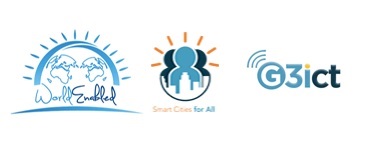Accessible and Inclusive Sidewalks in Quito, Ecuador
Accessible and inclusive sidewalks pose a 360° turn on our mobility as disabled individuals. There is nothing like enjoying your own autonomy and independence when moving – walking nimbly and safely. Additionally, walking around and skipping obstacles and architectural barriers requires significant time spending, not to mention the emotional toll we take with each barrier found along the way. We may be under stress, conflict, and tiredness, but we will never stop moving.
This artificial intelligence project is a great success when it comes to exercising the rights of disabled individuals, as it will allow us to choose routes and paths through a series of trajectory and autonomy needs. Thus, travel distances and paths will be a personal choice, and not an imposition from the perspective of individuals, entities, or institutions that are do not embody the disability.
It is worth noting that each human being walks, finds him/herself, and establishes his/her references while moving. However, if a person has a disability, the way he/she moves around the city, the neighborhood, or the town can be infinitely diverse, as each person’s walking is unique and authentic, since it is up to each person to understand how we adapt to each space, difficulty, or obstacle. And why not, the case may be that, sometimes, we choose not to adapt to the situations surrounding our environments, which can often prove complicated and even hard to surpass. The moving environments can vary between neighborhoods, even within the same city, and these differences exacerbate when comparing different countries or regions.
Consequently, I would like to commend G3ict and Washington University for their OpenSidewalks project, as it has achieved equal working conditions, where our involvement as individuals with disabilities has proven essential, while our standing as users of public spaces — such as pedestrian and public transportation roads — has been clearly respected. The motto “Nothing for us without us” (nada de nosotres sin nosotres) is fully enshrined in the development and execution of each stage of the project. Thus, the involvement of government entities, private entities, social organizations, and civil society individuals who embody the disabilities, along with our families, friends, and people that are sensitive to other people’s needs has been evident.
Our work has focused on assessing every feature we found in the various spaces of a city, including signs, crossings, and obstacles in the sidewalks — trees, manhole covers, raised features, etc. One aspect I found rather curious in my city are boxes that contain a locked telephone, which are secured to a post on the sidewalks. This is where taxi and transportation van associations receive their calls. To be honest, I was not familiar with these phone “booths”, and I found that there are but a few located around the city. I would like for sure to get a photograph with one of these devices, as I’m sure this will be an unforgettable experience the kind of which you don’t get to experience every day.
May diversity always be an opportunity for us all!
Related Posts
Upcoming Events
There are no upcoming events.





